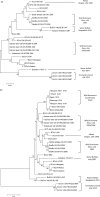Bovine-like coronaviruses in domestic and wild ruminants
- PMID: 30683171
- PMCID: PMC7108644
- DOI: 10.1017/S1466252318000117
Bovine-like coronaviruses in domestic and wild ruminants
Abstract
Coronaviruses (CoVs) produce a wide spectrum of disease syndromes in different mammalian and avian host species. These viruses are well-recognized for their ability to change tissue tropism, to hurdle the interspecies barriers and to adapt ecological variations. It is predicted that the inherent genetic diversity of CoVs caused by accumulation of point mutations and high frequency of homologous recombination is the principal determinant of these competences. Several CoVs (e.g. Severe acute respiratory syndrome-CoV, Middle East respiratory syndrome-CoV) have been recorded to cross the interspecies barrier, inducing different disease conditions in variable animal hosts. Bovine CoV (BCoV) is a primary cause of gastroenteritis and respiratory disease in cattle calves, winter dysentery in lactating cows and shipping fever pneumonia in feedlot cattle. Although it has long been known as a restrictive cattle pathogen, CoVs that are closely related to BCoV have been recognized in dogs, humans and in other ruminant species. Biologic, antigenic and genetic analyses of the so-called 'bovine-like CoVs' proposed classification of these viruses as host-range variants rather than distinct virus species. In this review, the different bovine-like CoVs that have been identified in domesticated ruminants (water buffalo, sheep, goat, dromedary camel, llama and alpaca) and wild ruminants (deer, wild cattle, antelopes, giraffes and wild goats) are discussed in terms of epidemiology, transmission and virus characteristics. The presented data denote the importance of these viruses in the persistence of BCoV in nature, spread to new geographical zones, and continuous emergence of disease epidemics in cattle farms.
Keywords: Bovine-like coronavirus; host-range variant; interspecies transmission; ruminant species; wildlife.
Figures

References
-
- Abd El-Karim IA, El-Sanousi AA, Aly NM and Reda IM (1990) Detection of coronavirus antigen in fecal samples obtained from newborn buffalo calves. Veterinary Medical Journal Giza 38, 77–85.
-
- Abd El-Rahim IHA (1997) Rota and/or coronavirus infections in newborn buffalo calves in Upper Egypt. Proceedings of the 4th Scientific Congress, Egyptian Society for Cattle Diseases Assuit, Egypt, pp. 210–220.
-
- Alagaili AN, Briese T, Mishra N, Kapoor V, Sameroff SC, Burbelo PD, De Wit E, Munster VJ, Hensley LE, Zalmout IS, Kapoor A, Epstein JH, Karesh WB, Daszak P, Mohammed OB and Lipkin WI (2014) Middle East respiratory syndrome coronavirus infection in dromedary camels in Saudi Arabia. MBio 5, e00884–14. - PMC - PubMed
-
- Alekseev KP, Vlasova AN, Jung K, Hasoksuz M, Zhang X, Halpin R, Wang S, Ghedin E, Spiro D and Saif LJ (2008) Bovine-like coronaviruses isolated from four species of captive wild ruminants are homologous to bovine coronaviruses, based on complete genomic sequences. Journal of Virology 82, 12422–12431. - PMC - PubMed
Publication types
MeSH terms
LinkOut - more resources
Full Text Sources

